A Center For Life-Changing Care
October 12th, 2018 by Global Down Syndrome Foundation
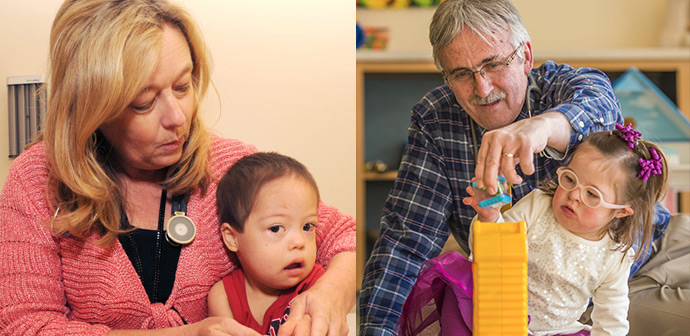
From Down Syndrome World Winter 2017
Since its inception in 2010, The Anna and John J. Sie Center for Down Syndrome at Children’s Hospital Colorado has championed healthy starts and bright futures by caring for the unique medical needs of young people with down syndrome.
WHEN HER DAUGHTER, Sophia, was born with Down syndrome 13 years ago, Michelle Sie Whitten, President and CEO of the Global Down Syndrome Foundation, traveled more than 1,000 miles from her home in Denver to the Thomas Center for Down Syndrome Services at Cincinnati Children’s Hospital Medical Center to find the specialized medical care Sophia needed. After talking with other local families making the same trek, Whitten began exploring what it would take to bring a similar center to Colorado.
“The initial thinking was, ‘Why should we have to travel?’” Whitten said. “Why shouldn’t Colorado have a fabulous, world-class pediatric medical center for kids with Down syndrome?”
From Whitten’s due diligence and efforts, and funding from Sophia’s grandparents, Anna and John J. Sie, came the Sie Center, a medical center that opened in 2010 at Children’s Hospital Colorado as part of the Linda Crnic Institute for Down Syndrome.
PUTTING POTENTIAL WITHIN REACH
“There’s a lot of talk about people with Down syndrome reaching their full potential,” Whitten said. “At Global, we feel very strongly that without good health, you’ll never reach your full potential.”
Helping children and young adults up to age 21, the Sie Center’s team of medical professionals provides the expert care and resources needed to manage a wide range of physical and behavioral health issues associated with Down syndrome. These specialists work closely with primary care providers at Children’s Hospital Colorado to coordinate care and deliver services through seven clinics.
At the Medical Clinic, a developmental pediatrician, nurse, and physical therapist evaluate children’s medical issues and physical growth to develop a comprehensive care plan. During visits, kids may also see an occupational therapist as needed.
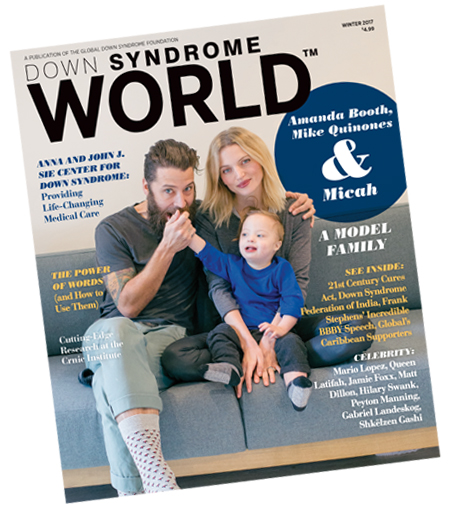 This article was published in the award-winning Down Syndrome World™ magazine. Become a member to read all the articles and get future issues delivered to your door!
This article was published in the award-winning Down Syndrome World™ magazine. Become a member to read all the articles and get future issues delivered to your door!The Sie Center’s Feeding Clinic offers families an opportunity to visit with a feeding and swallowing specialist, developmental pediatrician or nurse practitioner, physical therapist, and social worker. These providers help parents address muscle weakness and other issues with eating and drinking that can interfere with a child’s ability to breast-feed, chew, and/or swallow and therefore raise his or her risk of silent aspiration.
The ENT Clinic helps manage diseases of the ear, nose, and throat, including chronic ear infections, airway obstructions, and hearing loss. Approximately 70 to 75 percent of kids with Down syndrome deal with hearing loss, according to the Eunice Kennedy Shriver National Institute of Child Health and Human Development.
The Sie Center is the first center of its kind to have a full-time School-Age Clinic. The clinic’s educational specialist and psychologist help families develop individualized education programs and identify medical problems that may contribute to difficulties with behavior and learning. For example, a child who is acting out in gym class may do so because his feet hurt — not because he doesn’t want to participate in the activity.
“These specialists are like medical detectives,” Whitten said. “They work very closely to understand what’s happening at school and what modifications, support, and resources may be helpful.”
Through the Infant Clinic, babies receive a complete evaluation of their physical health to identify medical needs at a very early age.
At the Sleep Clinic, physicians evaluate children for sleep disorders and help parents troubleshoot solutions for common challenges, such as using a continuous positive airway pressure machine.
Currently, the Telemedicine Clinic connects Sie Center specialists with providers in Durango, Colorado, who treat children with Down syndrome, but Whitten said the goal is to expand the service to benefit the maximum possible number of patients.
In addition to these clinics, the Sie Center recently instituted a mental wellness program. Often, young people experiencing regression or warning signs of depression and anxiety are told that these symptoms are complications related to Down syndrome. However, these issues may be treatable mental illnesses, just as they would be for typical young adults.
A GLOBAL IMPACT
The clinic’s specialists are actively involved in clinical research projects that will help doctors around the world improve care for children with Down syndrome.
Arwen Jackson, MA, CCC-SLP; Jennifer Maybee, OTR, MA, CCC-SLP; Maura K. Moran; Kristine Wolter-Warmerdam; and Francis Hickey, M.D., FAAP, all with the Sie Center or Children’s Hospital Colorado, published their latest study on aspir ation in the international journal Dysphagia.
“Doctors at Children’s Hospital Colorado are also joint appointees at the University of Colorado School of Medicine, so we’re able to get a lot of medical students who are required to do a fellowship or some kind of rotation,” Whitten said. “Working with the Sie Center gives them an in-depth look at the best way to provide medical care to patients with Down syndrome, and that carries over to the care they give in the future.
“The services the Sie Center provides are nothing short of life-changing, if not lifesaving,” Whitten added. “I’ve spoken with parents who’ve told me, ‘I was always afraid, but now that I’m at the Sie Center, I understand what’s going on. I know what I’m supposed to be doing for my child’s health.’”
CARE COUNTS
The Anna and John J. Sie Center for Down Syndrome at Children’s Hospital Colorado is one of the largest centers of its kind in the world. Here’s a snapshot of the clinic’s impact:
• More than 1,500 visits take place at the Sie Center each year.
• The Sie Center serves approximately 1,300 patients annually.
• The pediatricians, specialists, and therapists at the Sie Center have more than 80 years collective experience caring for children with Down syndrome.
• Families representing 26 states, seven countries, and Puerto Rico seek care at the Sie Center.
Global provides continued financial support for the Sie Center. Visit The Sie Center web page to learn how you can help efforts to provide medical care for children and young adults with Down syndrome.
Like this article? Join Global Down Syndrome Foundation’s Membership program today to receive 4 issues of the quarterly award-winning publication, plus access to 4 seasonal educational Webinar Series, and eligibility to apply for Global’s Employment and Educational Grants.
Register today at downsyndromeworld.org!
A Country Star Bids Farewell
October 2nd, 2018 by Global Down Syndrome Foundation

From Down Syndrome World Spring 2016
FACING TERMINAL CANCER, Joey Feek, one half of the Grammy nominated country music duo Joey+Rory, knew her time was limited. Her husband would be left to raise “Indy,” their daughter with Down syndrome, without her. So she made a radical, selfless decision.
“She started going against everything in her being that told her to hold her baby even tighter, and instead, she handed the baby to me,” Rory wrote on his blog, This Life I Live, where he details their journey with honesty, sincerity, and grace. Rory said Joey felt it was best for him and Indy to strengthen their bond for the future. “She carried the pain on her own shoulders, to try to keep it off of mine — and even more so, off of Indy’s.”
Joey passed away on March 4, shortly after reaching one final goal — to see Indiana turn 2 — on a day that Rory called “nothing but joy and more joy.”
“[Indiana] has a way of bringing even the most painful parts of life back into perspective.”
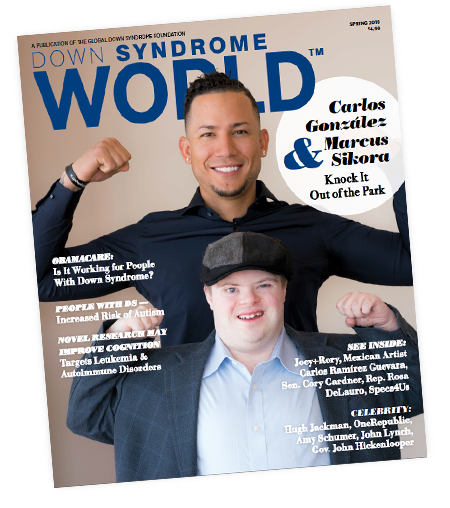 This article was published in the award-winning Down Syndrome World™ magazine. Become a member to read all the articles and get future issues delivered to your door!
This article was published in the award-winning Down Syndrome World™ magazine. Become a member to read all the articles and get future issues delivered to your door!
WHEN I’M GONE
Now their own version of a dynamic duo , Indy and Rory continue to work through common issues for a child with Down syndrome. She attends High Hopes Development Center, an inclusive preschool and pediatric therapy clinic in Franklin, Tennessee, which Joey and Rory selected together. Rory wrote that Indy loves being around all the other kids, gets physical therapy to learn to walk, and receives speech therapy to “start turning all the words she can say with her hands into sentences she can say with her mouth.”
“Joey was so excited about Indy getting the chance to come to High Hopes, and I was so thankful that she felt great about it.
Somehow she managed to transform her disappointment of not getting to raise and teach Indy into a real hope of something even better,” Rory reflected.
Indiana also delights in the world her mother loved so much, a country life on their farm.
“Like her mama, she likes being outside. She loves pointing out the horses to me, or making sounds like she’s telling me all about the flowers or the windmill that turns up on the hill,” he revealed.
FAITH IN THE FUTURE
Indy and Rory get through life’s challenges with help from an extended network of family and friends, including his two grown daughters from a previous marriage — Heidi and Hopie — as well as his manager, cousin, and friend, Aaron Carnahan, who had his own experience raising a son with Down syndrome.
Despite the extraordinary circumstances, Rory knows the time he and Indy shared with Joey will continue to give them hope.
“Tucked away in her little heart will be all of the beautiful memories of these first two years that she has shared with her mama, and when the
time is right, she will find them and they will make her smile,” Rory wrote.
“Yes, she will remember. I believe that.”
To learn more about Rory, Joey, and Indiana Feek, visit thislifeilive.com or facebook.com/joeyandrory.
Like this article? Join Global Down Syndrome Foundation’s Membership program today to receive 4 issues of the quarterly award-winning publication, plus access to 4 seasonal educational Webinar Series, and eligibility to apply for Global’s Employment and Educational Grants.
Register today at downsyndromeworld.org!
Megan Bomgaars & Kenneth Faried Conquering Challenges on the Road to Fame
September 29th, 2018 by Global Down Syndrome Foundation
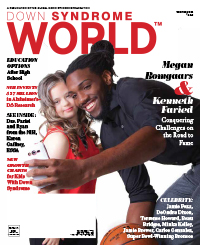
From Down Syndrome World 2016 Winter Issue
Global celebrates one of our favorite cover story features from 2016! Since then, the now Emmy-award winning Megan Bomgaars continues to rise in fame and Kenneth Faried still heating up the basketball court, now playing for the Brooklyn Nets.
Megan Bomgaars, one of the stars of A&E’s hit reality show Born this way, and Denver Nuggets’ power forward Kenneth Faried confronted their own unique challenges growing up. Today, both are using their wildly different talents and abilities to get one message across — even when life Isn’t easy, determination can make it rewarding.
AT FIRST GLANCE, the average person wouldn’t think that a bubbly 4-foot-11-inch, 22-year-old self-advocate and budding TV actress has much in common with a 26-year-old, 6-foot-8-inch NBA player. But these two Global Down Syndrome Foundation supporters share two traits: a passion for life and a desire to encourage kids to be their own self-advocates.
“I had a positive attitude and believed in myself in high school,” Bomgaars said. “Nobody should be limited just because they have Down syndrome.”
Added Faried, “Just because kids are different, doesn’t mean they should be picked on. Everyone needs to be treated equally, no matter their color, differences in ability, or anything else.”
Of course, both followed very different paths to arrive at these very similar philosophies.
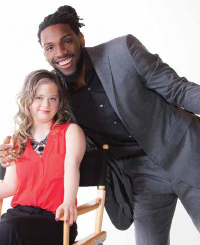
THE ROAD TO THE SILVER SCREEN
Bomgaars is one of six young adults with Down syndrome chosen to star in Born This Way, the A&E series that offers an intimate look into the lives of young men and women with Down syndrome. She landed the spot after catching the attention of the show’s producers while delivering a keynote address — one of many motivational speeches she delivers each year — at the 2015 National Down Syndrome Congress Annual Convention.
“Being involved in the TV show is important,” the young actress noted. “It changes people’s lives, and I want to share my story with the rest of the world.”
Bomgaars’ story begins with a childhood that was filled with speech, occupational, and physical therapies. In addition to a heart defect and a need for leg braces, she experienced feeding, respiratory, and vision problems as a very young child.
Her mother, Kris, attributes much of Bomgaars’ success in overcoming medical and developmental issues to a team of innovative therapists. Not only did they teach Kris how to continue her daughter’s therapies at home, but they also encouraged her to include Megan in everyday activities. When Bomgaars was 18 months old, Kris enrolled her in a typical childcare program. Interacting with other children her age, Bomgaars learned basic social skills and even sign language.
“That philosophy of inclusion has stuck with us ever since,” Kris said. “Megan has always been determined to do everything that her peers could do and more.”
Bomgaars carried that determination throughout elementary and high school. At age 19, she made the viral YouTube video, Don’t Limit Me, to encourage others to have high expectations for individuals with Down syndrome. A year later, she launched her own line of tie-dyed fashion accessories, called Megology.
At times, Bomgaars’ success even takes her mother by surprise. “I often hear other parents say ‘My kid could never do that,’” Kris said. “When Megan was born with multiple medical challenges and I was feeding her through a tube, I never would have expected in a million years that she would be as strong as she is today. I attribute it to her always raising the bar for herself.”
In 2015, Bomgaars’ feisty spirit earned her a trip to the White House. She and Devon Adelman represented the Global Down Syndrome Foundation as the first students with Down syndrome to be invited to First Lady Michelle Obama’s Reach Higher “Beating the Odds” Summit. The event celebrates young people who have overcome obstacles to enroll in higher education.
“That was a really big deal. It was awesome,” Bomgaars enthused. “And I am beating the odds, right now.”
Bomgaars has had a steady boyfriend, and they’ve talked about getting married, but like most mothers, Kris is concerned they’re too young and wants her to finish college.
“We love each other,” Bomgaars said. “We’ve been together for seven years.” As she mulls her future, Bomgaars attends the University of Colorado, where she’s studying filmmaking during gaps in the show’s production. “I want to make movies that change lives,” she said.
STORY OF A KINDRED SPIRIT
Life through Faried’s lens was a struggle as well, but for different reasons.
“My mother is a lesbian,” Faried said. “Young people whose parents are gay, lesbian, or transgender didn’t always receive the best support at the time, and I eventually had to learn that I couldn’t always get in a fight because some bully had an opinion about my mom.”
The self-described “skinny and long” teenager put his energy into basketball in the hopes it would one day lead to something bigger.
“I believe that if you put your mind and heart into something, you can achieve anything,” Faried added. “My parents always had my back.”
In fact, it was his mother who urged him to leave the environment of gangs, drugs, and violence in their Newark, New Jersey, neighborhood. And he did. In 2007, he started college at Morehead State University, almost 650 miles away in rural eastern Kentucky, where he’d been recruited to play basketball.
His college years were filled with homesickness, which caused his playing to suffer. During his junior year, his mother underwent a kidney transplant, and he became a father for the first time. Nevertheless, true grit and determination paid off. He was named the Ohio Valley Conference’s player of the year in both his junior and senior years, and as a senior, he led the NCAA in scoring, rebounds, blocked shots, and field-goal percentage — all of which contributed to him becoming a first-round draft pick for the NBA in 2011.
“I learned to never give up on something you love,” he said. “Overcoming challenges makes your achievements even more meaningful.”
Faried hasn’t stopped challenging himself during his five years playing for the Denver Nuggets. His public relations manager gave him the nickname “Manimal” because, according to Faried, “I play hard, I’m fearless, I don’t care who the person I’m facing is, and I am going to challenge him.”
In his personal life, however, Faried shows a softer side. Now the father of two daughters, Faried sees himself as someone who should be building bridges and encouraging understanding.
“You never know what challenges other people are experiencing,” he said. “When you encourage others, you are also encouraging yourself, demonstrating that you can make a difference in the world. Megan is the same way — she is a true light in the lives of everyone she meets.
28-year-old Kenneth Faried, who now plays for the Brooklyn Nets, is raising a family, and volunteers with Global Down Syndrome Foundation, walking in fashion shows and forming friendships with the kids he meets on the runway. We sat down with him to learn why he’s so passionate about advocating for people with Down syndrome.
Down Syndrome World: Why are you so inspired by children with Down syndrome?
Kenneth Faried: They’re brave, positive, strong individuals who understand how to live in the moment and love unconditionally. Working with these kids brings me joy and inspires me to take on the challenges of life and embrace every opportunity to live life to the fullest.
What do you tell kids to encourage them to pursue their own passions?
Keep a smile on your face. Let it shine brightly for everyone else around you. Never give up and always believe in your ability to overcome and succeed.
What do you wish you could say to children with Down syndrome everywhere?
Remember that you’re beautiful and never be afraid to be yourself. If people are making fun of you or trying to hurt you verbally, ignore them. Don’t let it get you down. Walk around with your head held high. Choose to be a blessing.
Like this article? Join Global Down Syndrome Foundation’s Membership program today to receive 4 issues of the quarterly award-winning publication, plus access to 4 seasonal educational Webinar Series, and eligibility to apply for Global’s Employment and Educational Grants.
Register today at downsyndromeworld.org!
Destiny: A foster child with Down syndrome Finds His Forever Mom
September 29th, 2018 by Global Down Syndrome Foundation
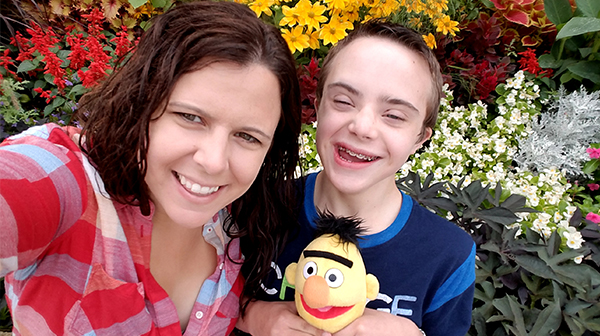
From Down Syndrome World 2018 Issue 2 of 4
When people first meet 15-year-old Brett Logan, they see a charismatic young man full of joy, laughter, and love. What they don’t see at first glance are the many struggles he has overcome to get to where he is.
From the time Brett was just an infant, he faced severe, life-threatening medical challenges. Doctors questioned if he would live into his adolescent years. Defying the odds, Brett prevailed. But in addition to being a medically fragile child with Down syndrome, Brett developed complex behavioral and social difficulties as a result of the neglect and abuse he endured during his upbringing. One evening when Brett was 8 years old, the local Department of Human Services found him wandering the streets of Greeley, Colorado, by himself in filthy clothes and no shoes. He was sent from foster home to foster home, never truly getting a chance to reach his potential.
A ROUGH START
Born with two heart defects, Brett was diagnosed with failure to thrive. At 20 months old, he had both croup and the flu, which caused his heart to stop and required weeks in the intensive care unit at Children’s Hospital Colorado. During that time, he became addicted to sedation medication and had to be treated with methadone.
When Brett began school, he w as delayed in all areas of development, ranging from nutrition to verbal language. At age 8, Brett was transferred from a different school district into then 22-year-old Jennifer Nelson’s class.
“He was very tiny — about the size of a 3 y ear old at age 8,” Jennifer recalled of the young Brett. “But through all that, I knew there was something really special about him. He had me wrapped around his finger from day one, and we developed a really close student-teacher bond.”
As the school year went on, Jennifer fell in love with Brett’s infectious personality. “He is really loving, empathetic, and funny,” Jennifer said. “He can always make me laugh, and he truly loves others like nobody I’ve ever met.”
After a year of being Brett’s teacher and getting to know him, the 23-year-old, barely out of college, took a life -changing gamble and adopted Brett. At the start of their journey, “they told us he was too old and if he hadn’t learned yet, he wasn’t going to,” Jennifer recalled.
“They were so wrong!”
Brett is now a sophomore in high school, more active and happier than ever before.
BECOMING A FAMILY
After a court hearing where it was clear that Brett would not be returning to his last home, Jennifer stepped up.
“I had decided pretty early on that I wanted to adopt him,” she said. “So many people had given up on him in his life, and I knew he deserved more. Somehow destiny brought us together.”
In 2015, Jennifer and Brett officially became a family. For the first time in his life, Brett had a real home.
“I was happy!” Brett said of learning Jennifer would be his adoptive mother. “My favorite thing about being adopted is that I get to sleep in my bed every night.”
“I will admit, it was very challenging at the beginning,” Jennifer said. “I became a parent of a 9-year-old overnight, when I was just barely out of college myself. I knew he was capable of learning. He just needed someone to teach him.”
THE POWER OF POSITIVITY
With the proper nutrition and medical care, Brett has grown in everyway imaginable, Jennifer said. He is physically larger, very verbal and talkative, and learns new things everyday.
Now a student at Legend High School in Parker, Colorado, Brett has a full calendar with show choir and varsity cheerleading. Off campus, Brett is involved in a number of extracurricular activities as a multi-sport Special Olympics athlete, Junior Denver Broncos Cheerleader, and active participant in Global Down Syndrome Foundation’s Dare to Cheer Camps. In fact, this will be his fourth year attending Dare to Cheer.
His newest interest, modeling, got him on the runway with Sam Cronin, a midfielder for the Minnesota United Major League Soccer team, at Global’s 2017 Be Beautiful Be Yourself Fashion Show.
“I loved everything about the fashion show,” Brett said. “I hope I get to be in it again someday. I loved dancing on the runway with all the cameras on me and the whole crowd cheering! My buddy Sam was awesome. He even gave me a piggyback ride after the show and waited with me until my mom got back.”
Brett still deals with medical challenges, including epilepsy, sleep apnea, and hypothyroidism, all of which have a higher prevalence in people with Down syndrome. But he takes them in stride and continues to prevail. In 2015, he was named an ambassador for Children’s Hospital Colorado for his perseverance through all his treatments.
“I love my doctors at Children’s Hospital, so it was great to be involved,” Brett said. “I got to meet other kids who also battle health issues, and it was great to just be me!”
Brett and his mother don’t know what the future holds, but are excited for all the possibilities that lie ahead.
“Don’t let anyone tell you that something is impossible,” Brett said. “I am proof that challenges can be over come and that you can do anything you put your mind to.”
BRETT LOGAN, IN HIS OWN WORDS
Favorite subject at school: “Guitar, because my teacher lets me have the stage and put on performances for my class.”
Favorite way to make people laugh: “By showing off my muscles or my dance moves!”
Best part of Dare to Cheer Camp: “I love hanging out with my friends and cheering for the audience.”
On being a Junior Denver Broncos Cheerleader: “I love my coaches Jozie and McKenna! They are my favorite part of cheer. I also love performing at the Bronco games. One time Demaryius Thomas threw a football to me on the sidelines!”
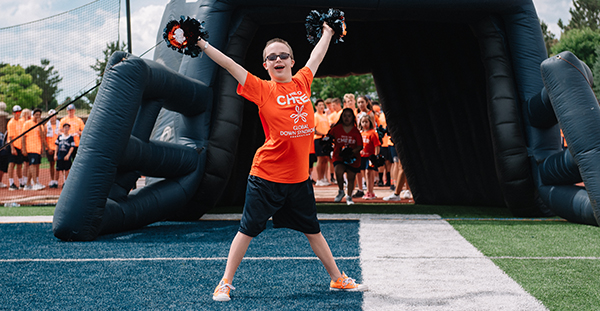
Like this article? Join Global Down Syndrome Foundation’s Membership program today to receive 4 issues of the quarterly award-winning publication, plus access to 4 seasonal educational Webinar Series, and eligibility to apply for Global’s Employment and Educational Grants.
Register today at downsyndromeworld.org!
Making History: First-Ever Gerber Baby with Down Syndrome
September 27th, 2018 by Global Down Syndrome Foundation
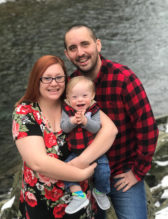
From Down Syndrome World 2018 Issue 2 of 4
In February 2018, a little boy with Down syndrome took the world by storm with his contagious smile, bright blue eyes and charming personality. His name is Lucas Warren, and he’s the first-ever Gerber Spokesbaby with Down syndrome.
The nearly century-old Gerber Products Company is an iconic brand that sells baby food and baby products. Often recognized by its trademark logo, a drawing of the first Gerber Baby, Ann Turner Cook, the company selects a new Gerber Spokesbaby each year. The 1-year-old from Dalton, Georgia, was chosen from 140,000 other contestants to be the Gerber Spokesbaby for the entire year. The Gerber brand personifies the healthy, happy, perfect baby. Choosing Lucas as the 2018 Gerber Spokesbaby challenges negative stereotypes about people with Down syndrome and makes an important statement about inclusion and diversity of those who are differently-abled. Global was able to share the excitement of this historical moment during an exclusive interview with Lucas’ parents, Cortney and Jason Warren.
DOWN SYNDROME WORLD™: TELL US ABOUT THE MOMENT YOU LEARNED LUCAS WON THE GERBER CONTEST.
Cortney and Jason: Our first reaction was shock and doubt, followed by extreme excitement for Lucas! We weren’t able to tell our families and friends until after it was announced.
WHAT AN EXCITING TIME SINCE LUCAS WON! HE HAS MILLIONS OF FANS ON SOCIAL MEDIA, AND EVEN INTERVIEWS ON THE TODAY SHOW. WHAT IS IT LIKE TO BE FAMOUS?
It is a proud moment for us as par ents knowing that Lucas has a platform to spread joy, not only to people he comes in contact with daily but to people all over the U .S. We are so happy that he will have this moment to look back on in the futur e and feel proud.
WHAT ARE LUCAS’ RESPONSIBILITIES AS THE 2018 GERBER SPOKESBABY?
Lucas will represent Gerber in advertisements, social media, and more throughout the year, representing joy and love. In addition, he receives $50,000 for his Spokesbaby title, which we plan to use toward his education.
WHAT HAS SURPRISED YOU ABOUT LUCAS?
What has surprised us the most about Lucas is Lucas himself. Being our first child, and having Down syndrome on top of that, everything is new to us. Seeing him pick up on milestones faster than what doctors and therapists say he should makes us feel so proud of him. He continues to show his doctors, therapists, friends, and family that there are no limits for him.
WHAT DO YOU HOPE HAVING LUCAS AS THE GERBER SPOKESBABY WILL DO FOR THE DOWN SYNDROME COMMUNITY AND SOCIETY IN GENERAL?
We hope this announcement will impact ever yone and shed light on the special needs community. We hope Lucas as the Gerber Spokesbaby will help educate more people that individuals with special needs should be accepted, not limited, and therefore have the potential to change the world.
Like this article? Join Global Down Syndrome Foundation’s Membership program today to receive 4 issues of the quarterly award-winning publication, plus access to 4 seasonal educational Webinar Series, and eligibility to apply for Global’s Employment and Educational Grants.
Register today at downsyndromeworld.org!
Food for Thought: Addressing Feeding and Swallowing Challenges
August 20th, 2018 by Global Down Syndrome Foundation
From Down Syndrome World Summer 2016
By Arwen Jackson, M.A., CCC-SLP; Bridget Harrington, M.A., CCC-SLP; and Carol Spicer, OTR/L, Anna and John J. Sie Center for Down Syndrome, Children’s Hospital Colorado
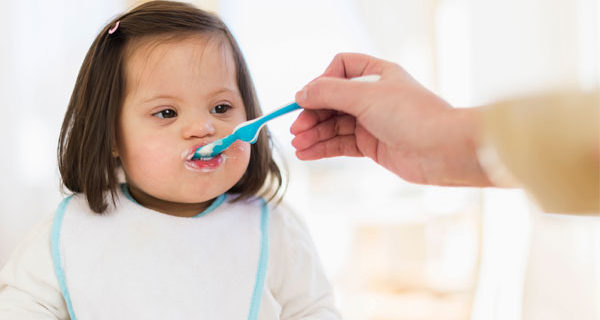
It’s important to identify and treat feeding and swallowing issues early to ensure your child with Down syndrome gets the most out of every healthy meal.
Children with Down Syndrome can encounter problems with feeding or swallowing due to physical, medical, or behavioral issues associated with their condition. Low muscle tone , sensory problems, food refusal, low endurance, or issues with oral motor skill development can all lead to problems that make eating difficult. This creates stress for children and their parents and can ultimately interfere with a child’s ability to grow and thrive.
A safe and enjoyable meal begins with attending to your child’s cues and supporting where he or she is developmentally.
BUILDING UP BABY
Both breast- and bottle-feeding help babies grow and develop oral motor skills. Beyond looking at your baby’s mouth, it is critical to observe the coordination of breathing and swallowing, the level of alertness, and beginning postural control. Babies do best with latching when they are in an awake, alert state. To help babies stay awake, talk to them, stroke their feet, or change their diapers.
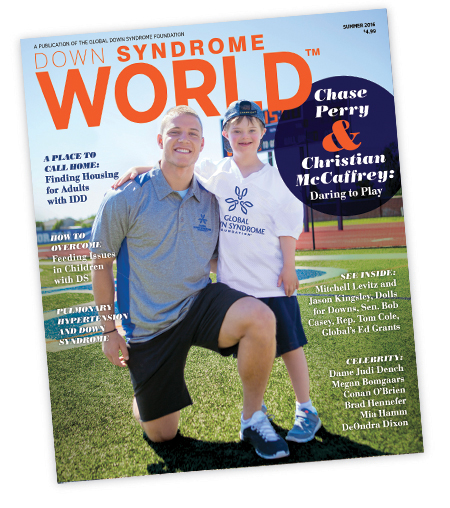 This article was published in the award-winning Down Syndrome World™ magazine. Become a member to read all the articles and get future issues delivered to your door!
This article was published in the award-winning Down Syndrome World™ magazine. Become a member to read all the articles and get future issues delivered to your door!
A pediatrician may suggest working with specialists, such as those at the Feeding Clinic at the Anna and John J. Sie Center for Down Syndrome at Children’s Hospital Colorado, to develop a safe and effective feeding plan that can be adapted to babies who breast-feed, bottle-feed, or both.
CAREFUL OBSERVATION
A parent’s power of observation is crucial in detecting issues with feeding and swallowing. Look for signs of swallowing difficulties, such as red watery eyes, coughing, choking, congestion, and chronic pulmonary or respiratory illness. Any of these could indicate dysphagia, or difficulty swallowing, which requires further medical investigation.
During meals, feeding difficulties may appear as prolonged or no chewing, overstuffing the mouth, and pocketing food. Behavioral signs related to feeding issues can include, but are not limited to, food refusal, inability to sit at the table, unwillingness to try new foods, or willful gagging and vomiting.
If your child is overstuffing his or her mouth, place two or three bites of food on a plate at a time and continue offering small servings. Children often have difficulty controlling the impulse to stuff their mouths when offered a full plate of food.
Poor postural stability also affects children’s ability to sit and actively participate in feeding themselves. If they cannot hold their heads up independently or have difficulty sitting, eating safely is more challenging. To improve posture, try holding your child in a more upright position on your lap or placing small towel rolls on either side of the trunk while in a high chair. This may offer enough support to free up the child’s hands for food exploration and self-feeding.
SETTING THE TABLE
If your child appears to have behavioral or sensory issues with food, try these tips to set him or her up for success:
- Lay the groundwork for fun and exploration before mealtime. Let children have a voice in what they want to eat and allow them to help with meal preparation — make a smoothie together, for example. Allow them to experience the sensory side of preparing food by touching, smelling, and of course, tasting the ingredients.
- Eat at their eye level. Children learn eating skills by watching you, so it’s important that you model these skills at their eye level.
- Listen — even when your child isn’t saying anything. Young children with Down syndrome may take longer to chew and swallow food than typical children. Don’t rush them. Understand that nonverbal cues, such as pushing a spoon away or turning the head to the side, are your child’s way of saying, “I’m not ready for another bite yet.” Respecting these signs builds trust, which is the foundation of a successful feeding relationship.
Finally, remember that every child is different and a one-size-fits-all approach to treating feeding and swallowing challenges may not work. Pediatricians and specialists can be invaluable resources, assisting parents in developing evidence-based, individualized feeding plans to help children find mealtime success.
PERSISTENT PROBLEMS
Feeding and swallowing challenges can follow individuals with Down syndrome into adulthood. If this happens, it’s important for friends, family, and caregivers to encourage or provide consistent, structured mealtimes.
Being attentive to adults’ feeding behaviors is important, as some people may not be able to verbalize that a problem, such as a cavity or pain when swallowing, is present. Refusal to eat, sudden shifts in food choices and nutrition level, and changes in normal feeding behavior may be clues that something is amiss.
READ MORE
The following resources provide additional information for parents whose children with Down syndrome have feeding and swallowing issues:
- Child of Mine: Feeding with Love and Good Sense by Ellyn Satter (Third Edition, Bull Publishing Company, 2000)
- Gross Motor Skills in Children with Down Syndrome: A Guide for Parents and Professionals by Patricia C. Winders (Woodbine House, 2007)
- Feeding Matters: feedingmatters.org
- “Healthy Eating Habits in Children with Down Syndrome,” National Down Syndrome Society: www.ndss.org/resources/nutrition/
Find a medical care center near you that specializes in treating patients with Down syndrome at www.globaldownsyndrome.org/research-medical-care/medical-care-providers.
Like this article? Join Global Down Syndrome Foundation’s Membership program today to receive 4 issues of the quarterly award-winning publication, plus access to 4 seasonal educational Webinar Series, and eligibility to apply for Global’s Employment and Educational Grants.
Register today at downsyndromeworld.org!
American Success Story
May 2nd, 2018 by Global Down Syndrome Foundation
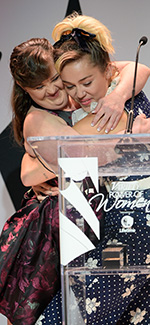
From Down Syndrome World 2017 Issue 2 of 4
Actor and model Jamie Brewer embraces the power of her celebrity to shatter stereotypes and be a voice for others — and counts superstar Miley Cyrus as an admirer.
In just a few short years, Jamie Brewer has become an icon and role model to legions of fans through her work on the hit TV show American Horror Story and as the first model with Down syndrome to appear in a New York Fashion Week runway show.
But last October, Brewer got to meet an idol of her own when she and Miley Cyrus shared a hug at the Beverly Wilshire hotel in Beverly Hills. Cyrus asked Brewer to introduce her at the Variety Power of Women event, where Cyrus received an award for her Happy Hippie Foundation. The foundation helps homeless youth and works more broadly to promote acceptance for lesbian, gay, bisexual, transgender, and queer (LGBTQ) youth and others who view themselves as different or feel they don’t fit in.
“We’ve never met in person before today, but I’m a huge fan of Jamie’s,” Cyrus said as she began her acceptance speech. “I thought she would beautifully encompass the Happy Hippie Foundation and all we represent.”
For Brewer, the moment was surreal — she was presenting Cyrus to a room full of acting luminaries including Helen Mirren, Ava DuVernay, Scarlett Johansson, and Laverne Cox.
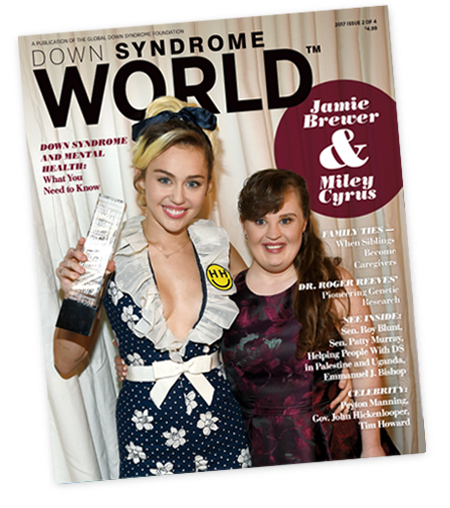 This article was published in the award-winning Down Syndrome World™ magazine. Become a member to read all the articles and get future issues delivered to your door!
This article was published in the award-winning Down Syndrome World™ magazine. Become a member to read all the articles and get future issues delivered to your door!“I’d been a fan of Miley’s and her father’s [musician Billy Ray Cyrus] for some time,” Brewer said. “I like her personality, which is down to earth and outgoing at the same time Miley heard of me and wanted me to present her with an award at the Power of Women luncheon. I was so excited she asked me. It was a very humbling experience.”
Their meeting at the event marked the start of a true friendship. Two months after the luncheon, Brewer attended a taping of the The Voice as a guest of Cyrus, who was a celebrity coach on the reality singing show.
Outside the spotlight, Brewer and Cyrus always have plenty to talk about when they’re together.
“We talk about lots of different things,” Brewer said. “Most of our conversations are just about life.” On that front, Brewer has a lot to share.
LOVING EVERY ROLE
Brewer, 32, grew up in Texas and southern California, where she currently lives. She caught the acting bug in the eighth grade when she played the role of Doctor Doolittle’s wife in a stage production of the beloved story about a man who can talk to animals.
She continued to act during and after high school, until her big break in 2011 — being cast as Adelaide “Addie” Langdon on the first season of the FX network’s American Horror Story. Adelaide was a young woman with Down syndrome mistreated by her mother.
“I got into the industry with Adelaide,” Brewer said. “Adelaide and I share a few natural traits, like personality and sass, so it was a very personal role.
“The whole experience on that first season w as so fun, especially for a huge horror fan girl like me,” Brewer added.
Brewer appeared in two more seasons of American Horror Story, as well as other network drama series and documentaries. Last year, she traveled to Australia to star in her first big-screen production, Kill Off, a short film about a woman who is differently-abled and uses street dance to bond with an African refugee.
Currently, she’s pursuing a bachelor’s degree in theater arts and working on another film, while also preparing to play the lead role in Amy and the Orphans, an off-Broadway play slated to open in New York in February 2018. The play is being produced by the Roundabout Theatre Company, one of the largest and most storied nonprofit theater companies in New York City, and directed by Scott Ellis, a seven-time Tony Award nominee.
BLAZING TRAILS FROM AN EARLY AGE
Regardless of whether she’s in Hollywood or Texas, advocacy has always been a running theme in Brewer’s life. From a young age, she challenged society’s perceptions of individuals with Down syndrome and their capabilities.
At age 18, she served as the youngest president ever elected to her local chapter of The Arc, The Arc of Fort Bend County. At age 20, she was asked to join The Arc of Texas Governmental Affairs Committee, where she worked with state lawmakers to pass legislation banning the use of the words “retard,” “retarded,” and “retardation” in Texas statutes. Brewer’s commitment to advocacy is one strong passion she shares with Cyrus.
BEHIND-THE-SCENES PHILANTHROPY
Although headlines about Cyrus tend to focus on her provocative performances, wardrobe, or latest social encounters, the artist has been working to give voice to the voiceless for most of her 24 years.
Like Brewer, Cyrus began her charitable work began as a child, when she would visit the coal mining towns of Kentucky with her family to bring clothes, gifts, and school supplies. As she got older, she raised money for and volunteered with a variety of nonprofits, including Youth Service America, Make-A-Wish® Foundation, and Feeding America, while also making individual contributions to earthquake recovery efforts in Haiti and to HIV/AIDS campaigns.
The Happy Hippie Foundation, launched in 2015, has been Cyrus’ most ambitious effort. In addition to its work with homeless teenagers and young adults, the foundation provides support, education, and job opportunities for LGBTQ and other at-risk youth.
The idea grew out of Cyrus’ 2014 MTV Video Music Award win, when she asked her date, a homeless young man named Jesse, to accept her award and deliver a speech on the plight of homeless youth in Los Angeles. Though many dismissed it as a publicity stunt, Cyrus managed to raise $200,000 for related charities within 24 hours.
‘EVERY LIFE IS VALUABLE’
Cyrus has told various media outlets that she felt dr awn to the problem of homelessness because it’s a problem so prevalent among LGBTQ teenagers and young adults. By some estimates, as many as 40 percent of clients served by homeless support organizations are LGBTQ, with the leading reason for their homelessness being family rejection related to their sexual orientation or gender identity.
Cyrus has also said that since a very young age, she struggled with her own gender identity and sexuality. Her personal struggles coming out to her parents and fans gave her an even closer connection to her foundation’s cause.
“No one should have to hide who they really are, no matter what his or her name, gender, status, or orientation,” Cyrus wrote in a blog post on the foundation’s website. “That’s why happy hippies are here to say that every life is valuable, and it is our mission to make sure those who question the value of themselves and their lives feel protected and loved by us … which they very much are.”
Brewer shares those same sentiments about inclusion for people with Down syndrome and others who don’t fit traditional molds.
In 2015, the Global Down Syndrome Foundation was proud to award Brewer its 2015 Quincy Jones Exceptional Advocacy Award for her inclusive viewpoints. “Receiving the Quincy Jones Exceptional Advocacy Award was a huge honor,” Brewer said. “Being recognized by Global was fitting because my advocacy is global. I don’t speak up to change things in one state. Everyone needs to have a voice.”
That’s one more point she and Cyrus can agree on.
BEHIND THE SCENES
How does actress Jamie Brewer work at her craft? Whom does she look up to in the film industry? We asked her those questions and more.
Q: HOW DO YOU PREPARE TO PLAY A ROLE?
Brewer: I always stay on my feet — that’s the biggest thing. I have to stay active to study and memorize the script. If I lie down while reading it, I fall asleep.
Q: WHICH ACTORS INSPIRE YOU?
Brewer: There are several I look up to and call mentors, including Chris Burke and Lauren Potter [both of whom have Down syndrome] and Sarah Paulson [who co-starred with Brewer in American Horror Story]. American Horror Story writer and producer Ryan Murphy is another.
Q: WHICH DIRECTORS WOULD YOU MOST LIKE TO WORK WITH?
Anyone, but definitely Alejandro G. Iñárritu and Martin Scorsese.
Q: WHAT’S SOMETHING YOU’RE LOOKING FORWARD TO?
Brewer: Graduating from college, although I don’t know when that
Transcending Cancer – Family And Fortitude
April 11th, 2018 by Global Down Syndrome Foundation

Family and fortitude helped Mary Miller overcome leukemia, and her inspiring fight could help change the future for thousands of more kids with Down syndrome facing the diagnosis.
Mary Miller, 13, of Finksburg, Maryland, is like a lot of girls her age. She loves school, swimming, making YouTube videos with her sisters, Lara and Sarah, and musical theater.
“My favorite thing about theater is the songs,” Mary said. “I like singing with my sisters.”
But at age 11, Mary’s full, vibrant life was interrupted by a leukemia diagnosis.
THE DIAGNOSIS: MUCH HIGHER IN CHILDREN WITH DOWN SYNDROME
Children with Down syndrome are 20 times more likely than typical children to develop acute lymphoblastic leukemia (ALL), also called acute lymphocytic leukemia. ALL is the most common childhood cancer and occurs when the bone marrow makes too many immature lymphocytes, a type of white blood cell, and spreads to the bloodstream. According to the nonprofit Cure Research For Childhood Cancer, ALL accounts for 25 percent of all cancers in children under age 15, and more than 3,000 new cases of ALL are diagnosed in children and adolescents in the U.S. each year.
Signs of childhood ALL include fatigue, anemia, weight loss, loss of appetite, fever, bone pain, swelling of the joints, enlarged lymph nodes, bleeding from the gums, and frequent infections. The type of doctor who treats blood cancers is called a hematologist-oncologist.
If a doctor suspects ALL or any leukemia in a child, most likely there will be blood tests, taking fluid from the bone marrow (bone marrow aspiration), and taking a small bit of bone and marrow (bone marrow biopsy). Treatment for ALL may include chemotherapy, immunotherapy, or targeted drugs that kill cancer cells.
FROM DESPAIR TO HOPE
Generally, the illness strikes children before age 5, so Mary’s diagnosis at 11 came as a shock to her parents, Jake and Jane, despite the higher risk she faced.
“Even as a nurse educator for Down syndrome, I was sucker punched,” said Jane, who coincidentally is an oncology nurse.
She learned of a Facebook group called Down Syndrome and Leukemia through another mother of a child also with Down syndrome and leukemia. Connecting with other parents whose children were going through what Mary was going through was a lifesaver, Jane said.
Through the Facebook group, Jane and Jake learned that many children with Down syndrome do not get a diagnosis as soon as they could. She learned many helpful care pointers, such as how to help with Mary’s head rash from her pillow by using a special port dress instead of a typical adhesive dressing, which can cause irritation, especially for people with Down syndrome, who tend to have more sensitive skin. She also found hope in a close friend, Cathy Fonfara-LaRose, whom she’d met through the Down Syndrome Connection in Maryland. Cathy’s daughter, Charlotte, and Mary had become friends at the Global Down Syndrome Foundation’s 2014 Be Beautiful Be Yourself Fashion Show in Washington, D.C.
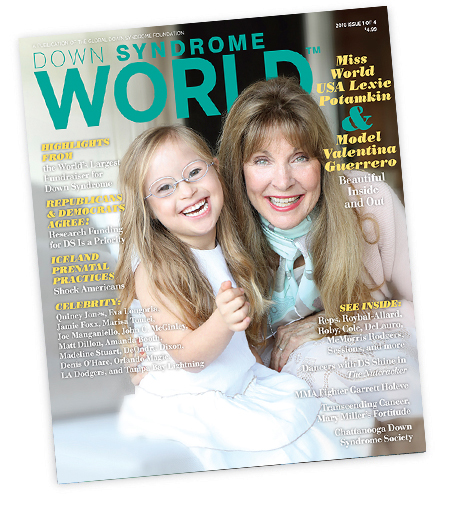 This article was published in the award-winning Down Syndrome World™ magazine. Become a member to read all the articles and get future issues delivered to your door!
This article was published in the award-winning Down Syndrome World™ magazine. Become a member to read all the articles and get future issues delivered to your door!Wanting to help Mary, as well as all the other kids with Down syndrome at risk for leukemia, Fonfara – LaRose worked with Global to establish the Mary Miller & Charlotte Fonfara-LaRose Down Syndrome & Leukemia Research Fund. The fund is underwriting a grant for Joaquín Espinosa, Ph.D., and his team at the Linda Crnic Institute for Down Syndrome, testing the effectiveness of drugs that inhibit two genetic mutations (MDM2 and CDK8) that cause uncontrolled cellular growth and proliferation linked to leukemia.
“This grant could really be the catalyst for some great research development with Down syndrome and leukemia,” Jane said.
A BRIGHT FUTURE
After two and a half years of grueling cancer therapies, including more than 200 nights in the hospital, Mary finished treatment in November 2017. She’s looking forward to a future that includes going to college and opening a restaurant with her father.
“Beating leukemia is the best,” Mary said. “I’m glad I don’t have procedures and that I don’t have to stay in the hospital.”
Throughout her entire journey, Mary’s parents marveled at her fortitude and determination.
“She doesn’t give up. She is optimistic in a w ay that is beyond my understanding, considering what she’s been through,” Jane said. “She’s a fighter.”
BRAVE, FUN, AND BEAUTIFUL
Thirteen-year-old Mary Miller was born to perform. One of the YouTube videos her sisters helped her create has nearly 50,000 views, and she didn’t let a cancer diagnosis get in the way of making more.
“I like making [YouTube videos] because they make people happy,” Mary said.
Now finished with cancer treatments, Mary wants other people with Down syndrome to learn what it takes to perform with grace: “They can learn to be brave and fun and that they are beautiful,” she said.
Like this article? Join Global Down Syndrome Foundation’s Membership program today to receive 4 issues of the quarterly award-winning publication, plus access to 4 seasonal educational Webinar Series, and eligibility to apply for Global’s Employment and Educational Grants.
Register today at downsyndromeworld.org!
Dance the Night Away
January 29th, 2018 by Global Down Syndrome Foundation
Shane Beard wants everyone to feel the love through music — so much so that he even named his DJ business The Love DJ.
“I always knew I wanted to be a DJ, since I was 11 years old,” Beard said. “I started to look up things about the music I liked, and then my mom kept searching for classes to train me.”
The search paid off when Beard’s mom, Carla Ellis, discovered the Global DJ Academy* in Denver and Walt White, the man who became Beard’s mentor.
“It has meant so much to him to play music. He is so proud of himself and feels he has his own career path now, something he enjoys and is good at,” Ellis said. “What I like best about being a DJ is letting the people have a great time and watching them have fun and feel the love,” Beard said.
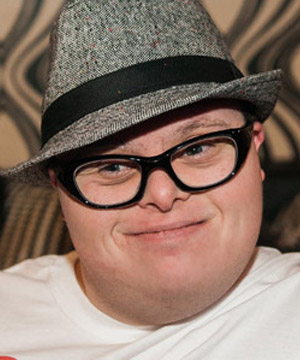
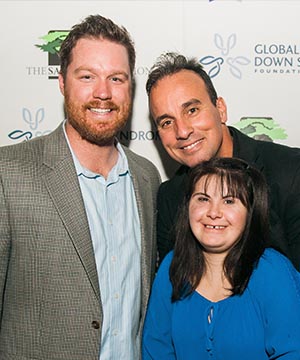
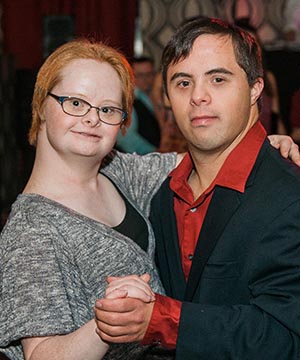
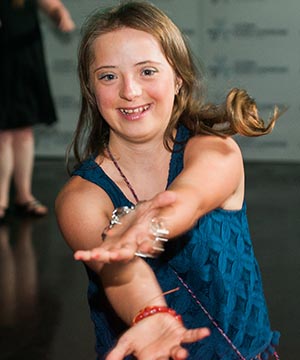
With a website and YouTube channel in the works, Beard strives to share his positive message and has lined up other DJ gigs, including one with his church. And if you want to know if it’s Beard behind the turntables, just look for his trademark hat.
“I always wear a fedora when I DJ,” he said. “It makes me feel special.”
I Love You Dance Parties
Global Down Syndrome Foundation’s I Love You Dance Parties provide the perfect place for adults with Down syndrome to kick up their heels, lift their spirits, and raise awareness.
Whether a person has twinkle toes or two left feet, Global’s I Love You Dance Parties embrace everyone. Designed to provide a real-life, age-appropriate experience for adults with Down syndrome and their friends and families, the events deliver a wealth of benefits to the community — promoting independence, exercise, and social interaction.
“They help me to get out of the house and see my friends that I don’t always see,” said self-advocate Rachel Greenlaw.
SOCIAL NETWORKING — AND SELF-ADVOCATING
“This is a place where self-advocates can get out and get moving. They’re not sitting and watching TV, and most of our folks love music and dance,” said Dennis McGuire, Ph.D., Senior Consultant at Global and a behavioral expert with more than 30 years of experience in mental health and developmental disabilities. “Having something to look forward to, to go out and not be stuck at home where you’re more likely to be depressed or just not enthusiastic about life, is vitally important.”
Beth Burczyk has attended 12 dance parties so far and likes the mature, elegant bar atmosphere that includes the option to enjoy a single cocktail or a “mocktail.”
“It’s fun and adult,” Burczyk said. “Going makes me feel comfortable and confident that I can do things like this and that it’s OK.”
“The events are very positive and upscale,” added Burczyk’s mother, Laura. “Global provides a safe environment, and the dances are always fun.”
A generous grant from The Salah Foundation, which supports nonprofit organizations that strengthen families and communities, helps fund the events. Held quarterly in downtown Denver and hosted by a celebrity emcee, the parties have attracted as many as 150 people per event and help fill the striking social void that can develop after schooling ends.
The parties also present ample opportunity for adults with Down syndrome to advocate for themselves, for example, by coordinating their transportation, paying with money they’ve earned, or making sure they are served what they ordered.
“It gives Rachel a positive feeling of independence,” said Greenlaw’s mother, Diane. “Even though there are chaperones at the dances, the chaperones include themselves as friends and dance, too.”
For self-advocate and DJ Shane Beard, the dance parties turned into a chance to showcase his talent and love of music. After attending several events, he recently took to the turntables to entertain the crowd at both the 2016 Hollywood Ball and the December I Love You Dance Party.
“DJing the dance parties has helped me share with people the music that speaks to the heart and helps people feel special,” Beard said. “That makes me proud to see everyone happy.”
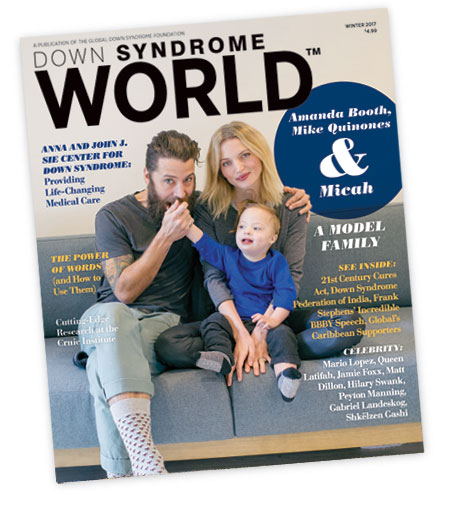 This article was published in the award-winning Down Syndrome World™ magazine. Become a member to read all the articles and get future issues delivered to your door!
This article was published in the award-winning Down Syndrome World™ magazine. Become a member to read all the articles and get future issues delivered to your door!
ONE NIGHT, A LASTING IMPACT
“The events are critical to their sense of self-worth, feeling included and excited about their journey as adults,” added Beard’s mom, Carla Ellis, who attends with him. “It’s pure joy, with loads of laughter. It’s always an experience for everyone — parents, caregivers, friends, self-advocates, all on the dance floor, just letting loose and having fun.”
The aim to keep participation balanced between self-advocates and the typical population ultimately serves a long-term goal of building strong friendships and relationships that change the way people perceive individuals with Down syndrome. Plus, having planned activities does more than simply fill an evening, according to Dr. McGuire.
“Our guys love schedules, and when they have one, all of a sudden they’re involved in the world, dancing, doing activities,” Dr. McGuire said. “They have a sense of control and participation in things. It changes their sense of themselves in so many positive ways.”
Like this article? Join Global Down Syndrome Foundation’s Membership program today to receive 4 issues of the quarterly award-winning publication, plus access to 4 seasonal educational Webinar Series, and eligibility to apply for Global’s Employment and Educational Grants.
Register today at downsyndromeworld.org!
Pizza, Pasta — And Purpose In Life
January 2nd, 2018 by Global Down Syndrome Foundation
The Sunflower Inn Near Rome Provides Jobs While Serving Up Favorite Italian Dishes With A Side Of Happiness.
In Italy, the sunflower represents happiness. So in 2000, when the parents of a teenager with Down syndrome opened a restaurant near Rome with the aim of employing people with the condition, they named it La Locanda dei Girasoli, or “The Sunflower Inn.” The idea was that people with Down syndrome are happy and would bring customers much happiness as well. The restaurant, the only one of its kind in Italy, quickly became a national phenomenon and garnered international press.
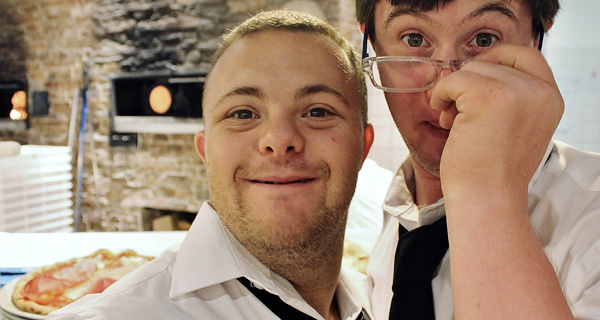
However, starting a business is not for the faint of heart. During an economic crisis in 2013, the owners were faced with the possibility of shutting down. Luckily, a social cooperative called Consorzio SINTESI was able to take over the restaurant and even expand its r each. Consorzio SINTESI specializes in giving jobs to people who are differently-abled and also manages call centers and tech support services for large companies.
People working at The Sunflower Inn have a work contract, and the goal is to employ them for the long-term. They are part of a network of people who are differently-abled whom the cooperative helps in many settings. For those interested and qualified to cook, there is a special program that allows them to learn f rom some of the top chefs in Italy.
BENEFITS OF A RIGOROUS CULINARY EDUCATION
Today, the restaurant’s staff includes eight people who are differently-abled, five of whom have Down syndrome. Of those five, two work as sous, or assistant, chefs.
Employees must be 18 years old, have Down syndrome or some other intellectual disability, be unemployed, have a lower secondary school diploma, and have receivedcertification for work eligibility from the Italian government.
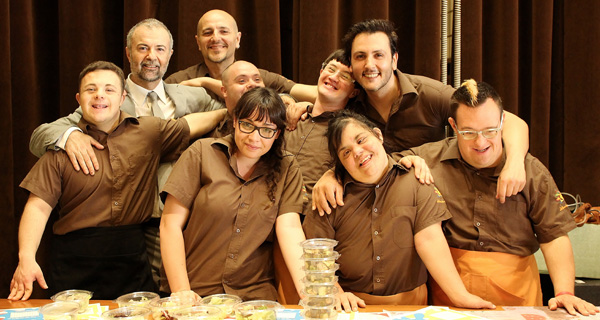
All employees begin as interns and complete a combined 600 hours of orientation, classroom training, and practical experience, which makes up more than 400 of those hours.
All the positions at The Sunflower Inn, including internships, are paid. “These jobs provide some financial security and a sense of autonomy,” said Enzo Rimicci, President of Consorzio SINTESI. “All the employees work hard, are extremely professional and have great pride in their work. This has led to increased confidence, which in turn leads to other growth, such as improved language skills or the ability to take public transportation.”
The employees themselves agree. When asked what they like best about their jobs they reply, “Teamwork!” and, “It’s like a family!”
A MOVEABLE FEAST
The Sunflower Inn has many regulars, according to Rimicci, and it has earned a 4.5 rating on TripAdvisor, where glowing reviews have given it a reputation as being a place that locals and tourists alike enjoy visiting. For some international tourists, it has become somewhat of a mecca.
 This article was published in the award-winning Down Syndrome World™ magazine. Become a member to read all the articles and get future issues delivered to your door!
This article was published in the award-winning Down Syndrome World™ magazine. Become a member to read all the articles and get future issues delivered to your door!The restaurant and the cooperative don’t receive any state aid and have to be selffunding. Catering is their main source of revenue, with their primary work focused on private events, sporting events, and restaurant collaborations. They have also launched an anti-bullying campaign in schools.
Rimicci represents the energy for his community, “We never stop! We have not yet managed to realize the dream of opening a second restaurant in southern Italy. It’s a big economic investment for our pockets today, but we’re sure that will come true tomorrow!”
GLOBAL CHALLENGES, LOCAL SOLUTIONS
In Italy, as in the U.S. and other countries, people who are differently-abled struggle to find jobs or meaningful activities after their public school education.
Enzo Rimicci, president of social cooperative Consorzio SINTESI, believes that this situation is dangerous for the well-being of those who are differently-abled and for our society. In addition to creating employment opportunities for people with intellectual disabilities in restaurant and catering settings, Consorzio SINTESI also provides employees the opportunity to become self-advocates. For example, in 2015, Consorzio SINTESI established the Inclusive Schools program. The program has been embraced by the local community. It provides the restaurant employees the opportunity to co-present at schools where they emphasize anti-bullying and teach children respect for diverse abilities.
Visit lalocandadeigirasoli.it to learn more and for links to the restaurant’s Facebook page and YouTube channel, where you can learn their easy recipe for Cacio e Pepe (cheese and pepper pasta).
Like this article? Join Global Down Syndrome Foundation’s Membership program today to receive 4 issues of the quarterly award-winning publication, plus access to 4 seasonal educational Webinar Series, and eligibility to apply for Global’s Employment and Educational Grants.
Register today at downsyndromeworld.org!

 Experience our inspirational and groundbreaking videos and photos. Our children and self-advocates are beautiful AND brilliant!
Experience our inspirational and groundbreaking videos and photos. Our children and self-advocates are beautiful AND brilliant! Make sure your local Representatives are on the Congressional Down Syndrome Task Force.
Make sure your local Representatives are on the Congressional Down Syndrome Task Force.